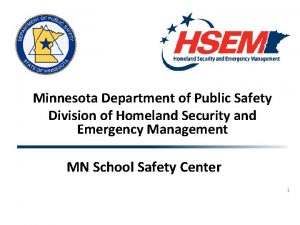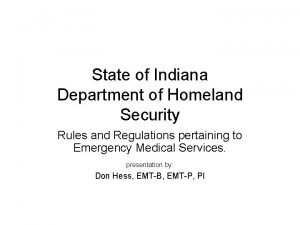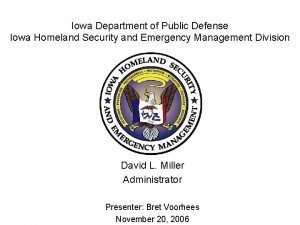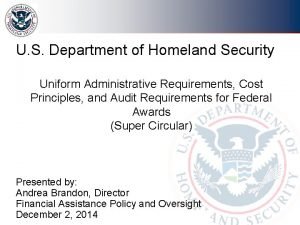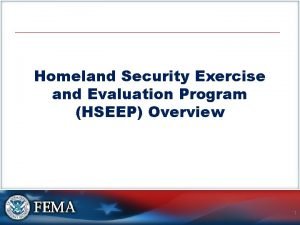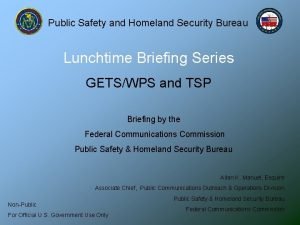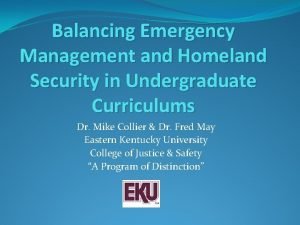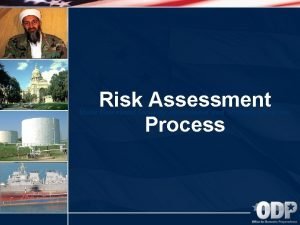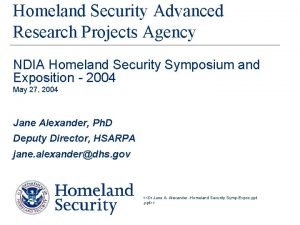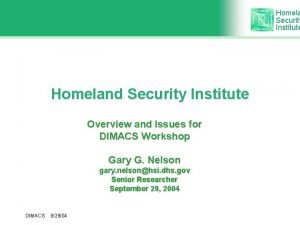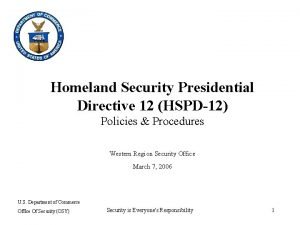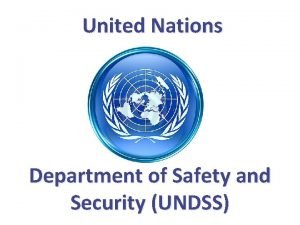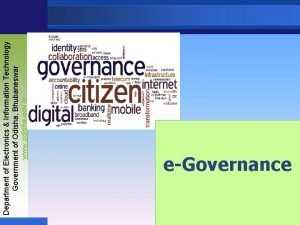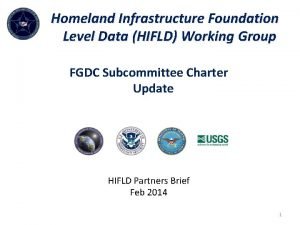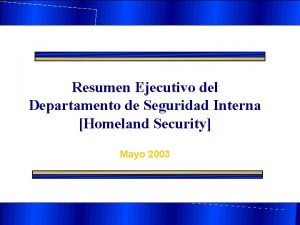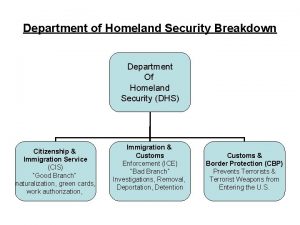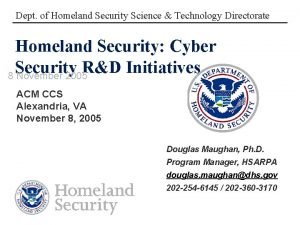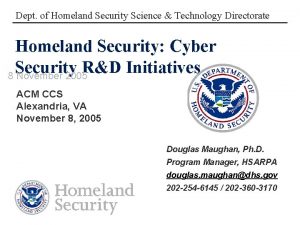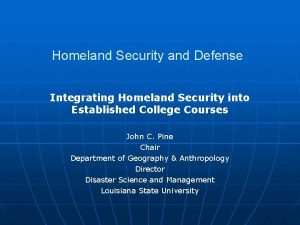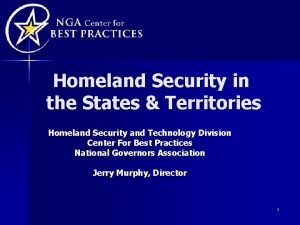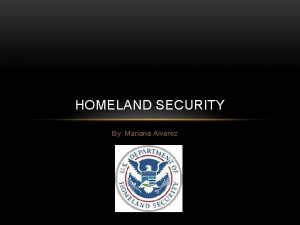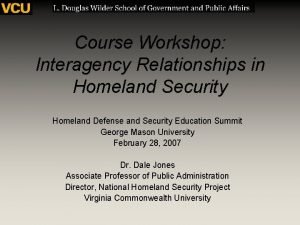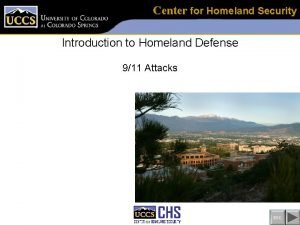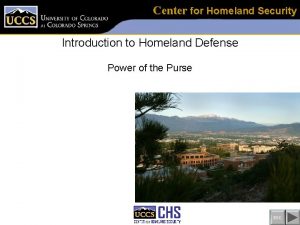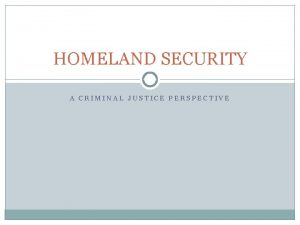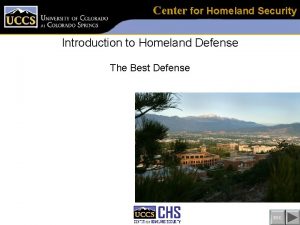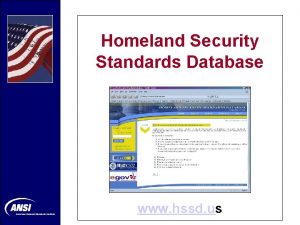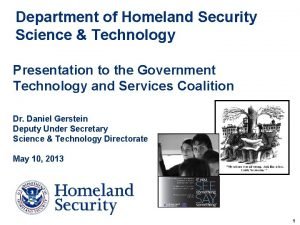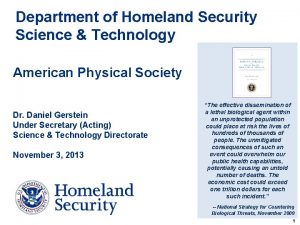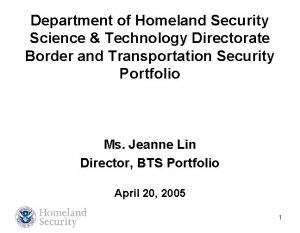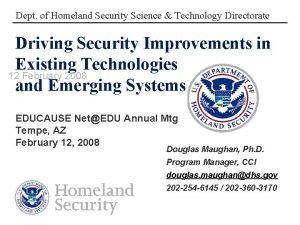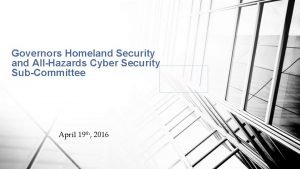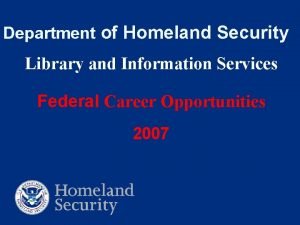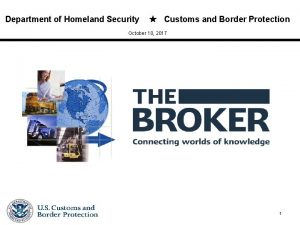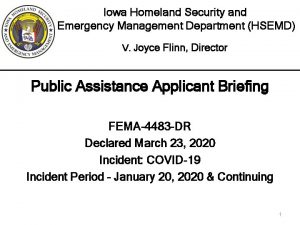Department of Homeland Security Science Technology Science and
































- Slides: 32

Department of Homeland Security Science & Technology Science and Technology in Disasters— Preparedness Opportunities Revealed by Sandy NJIT Forum on Managing Floodwaters and Economic Recovery Dr. Mitchell Erickson Interagency Office Science & Technology Directorate 18 November 2013 1

2

3


Hurricane Sandy Rebuilding Task Force Established to support federal, state, and local officials to rebuild stronger, safer, and more resilient communities. Report issued August 2013

v 6

Sandy Task Force o Task Force Chair § U. S. Department of Housing and Urban Development - Shaun Donovan, Secretary o Task Force Members § 26 Federal Agencies o o TASK FORCE ADVISORY GROUP § The Task Force Advisory Group was composed of State, local, and Tribal elected leaders from the most § severely impacted cities and towns in the region. § New York § New Jersey § Connecticut § Maryland § Rhode Island § Shinnecock Indian Nation STAFF AND DETAILEES § o 67 SCIENCE COORDINATION GROUP § 10 Federal Agencies & staff

Hurricane Sandy Rebuilding Strategy: Stronger Communities, A Resilient Region This Rebuilding Strategy establishes guidelines for the investment of the Federal funds made available for recovery and sets the region on the path to being built back smarter and stronger with several outcomes in mind: • Aligning this funding with local rebuilding visions. • Cutting red tape and getting assistance to families, businesses, and communities efficiently and effectively, with maximum accountability. • Coordinating the efforts of the Federal, State, and local governments and ensuring a region-wide approach to rebuilding. • Ensuring the region is rebuilt in a way that makes it more resilient – that is, better able to withstand future storms and other risks posed by a changing climate. http: //portal. hud. gov/hudportal/HUD? src=/press_releases_media_advisories/2013/HUDNo. 13 -125.

Recommendations o 69 Specific recommendations o 6 issues: § Promoting Resilient Rebuilding, Based on Current and Future Risk, Through Innovative Ideas § Ensuring a Regionally Coordinated Resilient Approach to Infrastructure Investment § Providing Families Safe, Affordable Housing Options and Protecting Homeowners § Supporting Small Businesses and Revitalizing Local Economies § Addressing Insurance Challenges, Understanding, and Accessibility § Building Local Governments’ Capacity to Plan for Long- Term Rebuilding and Prepare for Future Disasters

10

11

. ” e b to nd ed player, a s u all t it a , baseb h w t er ’ h n p i a so ilo e h r p u n fut rica e me h A , T a “ Berr r. e i Yog manag team

Challenges for Disasters 1. Water management 2. Make a compelling case for resilient infrastructure 3. Work with, not against, Mother Nature 4. Monitoring and diagnostics of infrastructure health 5. Communications in challenged environments 6. Informing the community 7. Risk models that include direct and indirect costs (quality of life…) 8. The data deluge

Grand Challenges for Disasters o Cut the cost of disaster management in half o How do we want our community to look in 50 years?


Mitch Erickson Science Advisor Interagency Office Department of Homeland Security Science and Technology Directorate Mitchell. erickson@hq. dhs. gov

The Lens of Hurricane Sandy o One of the most devastating storms in US history--$60 B and counting o Sandy hit an area not frequently impacted by hurricanes. o Future: § More more-violent weather? § Sea-Level Rise o Natural Disaster o Many lessons learned (re-learned? ) § Update building codes, laws and other issues that do not involve S&T § S&T can contribute to a more resilient society. o Sandy is a lens to focus attention on capability gaps. o USA is implementing: Sandy Rebuilding Task Force


Con. Ed Substation @14 th St & FDR

§ Lake Borgne Surge Barrier

Hoboken, NJ


Capability Gap Categories Infrastructure hardening Models and assessment tools Water Control Electric Power Other Lifeline Infrastructure Resilience Training and Exercises Analysis Communications Big Data Other

PPD-8 The National Preparedness Goal o To have a secure and resilient Nation with the capabilities required across the whole community to prevent, protect against, mitigate, respond to, and recover from the threats and hazards that pose the greatest risk. 30 Mar 2011 http: //www. dhs. gov/presidential-policy-directive-8 -national-preparedness http: //www. whitehouse. gov/blog/2011/10/07/ppd-8 -announcing-national-preparedness-goal o FEMA Implementation: § A National Preparedness System Description; § A series of National Frameworks and Federal Interagency Operational Plans; § A National Preparedness Report; and § A Campaign to Build and Sustain Preparedness o Sandy Observations: § Innovative volunteer efforts § Social media extensively used § Many elderly died of hypothermia over several days § Where can we save lives? Money? Heart ache? Jobs/Economy?

PPD-21 Critical Infrastructure Security and Resilience It is the policy of the United States to strengthen the security and resilience of its critical infrastructure against both physical and cyber threats. The Federal Government shall work with critical infrastructure owners and operators and SLTT entities to take proactive steps to manage risk and strengthen the security and resilience of the Nation's critical infrastructure, considering all hazards that could have a debilitating impact on national security, economic stability, public health and safety, or any combination thereof. These efforts shall seek to reduce vulnerabilities, minimize consequences, identify and disrupt threats, and hasten response and recovery efforts related to critical infrastructure. 12 Feb 13 http: //www. whitehouse. gov/the-press-office/2013/02/12/presidential-policy-directive-critical-infrastructure-security-and-resil

PPD-21 Critical Infrastructure Security and Resilience-2 o FEMA Implementation: § Develop a situational awareness capability that addresses both physical and cyber aspects of how infrastructure is functioning in near-real time § Understand the cascading consequences of infrastructure failures § Evaluate and mature the public-private partnership § Update the National Infrastructure Protection Plan § Develop comprehensive research and development plan http: //www. dhs. gov/sites/default/files/publications/EO-PPD%20 Fact%20 Sheet%2012 March 13. pdf o Sandy Observations: § Situational awareness could have been better § Cascading consequences … no electricity, no fuel § Public-private partnerships maturing § R&D Plan…Today!

ONE MONTH LATER: Fires still smolder in the South Manoloking section of Brick Twp. Aerials of the Ocean County shore. Brick Twp, NJ 10/31/12 (Andrew Mills/The Star-Ledger)


TRANSCOM Report 3 Nov 2012 29

Masdar UAE

Rebuilding Principles The Hurricane Sandy Rebuilding Strategy is focused through the principles of: o Resilience and sustainability o Regional coordination o Leadership and local primacy o Capacity building o Timeliness and flexibility o Equity and inclusiveness o Innovation o Public information o Leveraging and sustaining resources to maximize impact o Science-based and data-driven

26 Fed. Agencies o Task Force Chair § U. S. Department of Housing and Urban Development - Shaun Donovan, Secretary o Task Force Members § § § § § § § U. S. Department of the Treasury – Jacob Lew, Secretary U. S. Department of the Interior – Sally Jewell, Secretary U. S. Department of Agriculture – Tom Vilsack, Secretary U. S. Department of Commerce – Penny Pritzker, Secretary U. S. Department of Labor – Thomas Perez, Secretary U. S. Department of Health and Human Services – Kathleen Sebelius, Secretary U. S. Department of Transportation – Anthony Foxx, Secretary U. S. Department of Energy – Ernest Moniz, Secretary U. S. Department of Education – Arne Duncan, Secretary U. S. Department of Veterans Affairs – Eric Shinseki, Secretary U. S. Department of Homeland Security – Janet Napolitano, Secretary U. S. Environmental Protection Agency – Regina Mc. Carthy, Administrator Small Business Administration – Karen Mills, Administrator U. S. Army Corps of Engineers – Jo-Ellen Darcy, Assistant Secretary of the Army (Civil Works) White House Office of Management and Budget – Sylvia Burwell, Director White House National Security Staff – Lisa Monaco, Assistant to the President for Homeland Security and Counterterrorism White House Domestic Policy Counci - Cecilia Muñoz, Director National Economic Council – Gene Sperling, Director White House Council on Environmental Quality – Nancy Sutley, Chair White House Office of Science and Technology Policy - John Holdren, Director White House Council of Economic Advisors – Jason Furman, Chair White House Office of Public Engagement and Intergovernmental Affairs – Valerie Jarrett, Senior Advisor to the President White House Office of Cabinet Affairs – Danielle Gray, Assistant to the President and Cabinet Secretary
 Department of homeland security minnesota
Department of homeland security minnesota Indiana department of homeland security ems
Indiana department of homeland security ems Nys dept of homeland security
Nys dept of homeland security Iowa department of homeland security
Iowa department of homeland security Department of homeland security uniforms
Department of homeland security uniforms What is hseep
What is hseep Public safety and homeland security bureau
Public safety and homeland security bureau Homeland security infrastructure program
Homeland security infrastructure program Eku homeland security
Eku homeland security Homeland security vulnerability assessment
Homeland security vulnerability assessment Hsarpa sbir
Hsarpa sbir Homeland security advanced research projects agency
Homeland security advanced research projects agency Homeland security acronym
Homeland security acronym Homeland security
Homeland security Homeland security institute
Homeland security institute Homeland security presidential directive 12
Homeland security presidential directive 12 Homeland intelligence technologies
Homeland intelligence technologies Private secruity
Private secruity Science fusion introduction to science and technology
Science fusion introduction to science and technology Un department of safety and security
Un department of safety and security Oklahoma alternative placement program
Oklahoma alternative placement program Oklahoma department of career and technology education
Oklahoma department of career and technology education E & it department odisha
E & it department odisha Slovakia my homeland
Slovakia my homeland Anglo saxon homeland
Anglo saxon homeland Hifld data
Hifld data Homeland resumen
Homeland resumen Homeland av club
Homeland av club Homeland
Homeland Homeland
Homeland Freedom cave slovakia
Freedom cave slovakia A new settlement that keeps close ties to its homeland
A new settlement that keeps close ties to its homeland Wireless security in cryptography
Wireless security in cryptography
